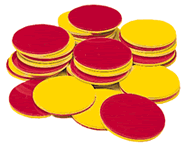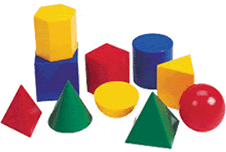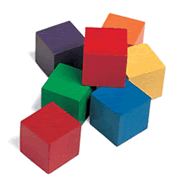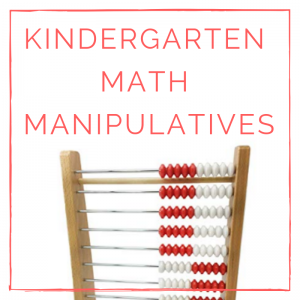The following 10 math manipulatives are not only great for teaching math concepts and vocabulary, they also encourage imaginative play and exploration. Young children need hands-on interaction with 3-dimensional math manipulatives when learning math.
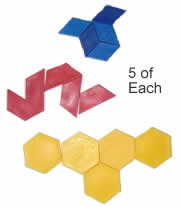
Using math manipulatives makes it easier for kids to discuss their math thinking with you and their peers, encourages them to ask questions, enables them to understand concepts, find multiple ways to solve problems, and helps them to demonstrate their new knowledge and skills.
Before spending money on math manipulatives, test them against the following criteria:
- The math manipulative is terrific for teaching multiple math concepts
- The math supplies are tough enough to withstand constant use by children and regular washing
- The math equipment can be used for math games and imaginative play
- The math manipulative passes testing standards and is certified to be non-toxic and child safe
- They can be used for learning more advanced math concepts as children grow
So here’s my list of favorites!
1. Pattern blocks
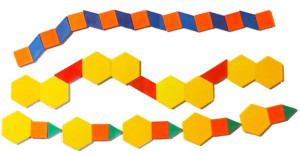
Pattern blocks are my number one winner as far as using a math manipulative for more than one purpose. They are definitely versatile.
They come in six colors and shapes – yellow hexagon, green triangle, blue diamond-shaped rhombus, red trapezoid, orange square and a smaller beige rhombus.
Pattern blocks can be used to teach everything from number sense, graphing, tessellation, fractions and more. They come in wood or plastic.
2. Colored wooden blocks
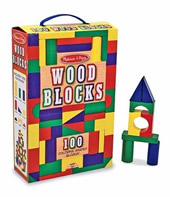
Colored wooden blocks come in many shapes and are invaluable for teaching geometry, symmetry, number sense, counting, patterns, and more. When children build with them they have practice problem solving and planning and activities such as stacking blocks teach children about balance and gravity. Building with blocks encourages the development of social skills as kids play together.
3. Unifix® cubes
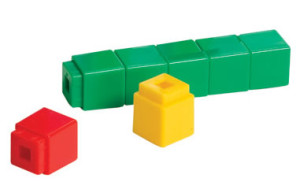
As students work on patterning, counting, and operation skills, pushing the square cubes together builds small motor and eye-hand coordination too. Unifix™ cubes are great for math games too.
4. Base ten blocks
As preschool and kindergarten students play with base 10 blocks, they learn the vocabulary of ones blocks, tens blocks, hundreds blocks and thousands block.
The children learn by playing, that 10 one hundred blocks are the same size as a one thousand block, that 10 tens-blocks are the same size as a one hundred block, and that 10 ones-blocks are the same length as a ten block. Children that are ready can build numbers with them. E.g. 185 – a one hundred block, 8 tens-blocks, and 5 ones blocks
5. Fraction circles
Fraction circles are made of foam or wood and some are magnetic. They are terrific for teaching students about fractions and their relationships.
When young children begin using them they see, feel, and compare equivalent fractions and as they get older the fraction terms become meaningful from their previous play experiences. Teach fraction vocabulary such as whole, halves, thirds, fourths, fifths, sixths, eighths, and tenths as the students play.
6. Two-sided counters
Two-sided counters are about one-inch in diameter and have one red side and one yellow side. These math manipulatives are great for teaching number sense and number operations. Put 5 in a container, have the children shake them, place them on the carpet or table, then count – 3 yellow and 2 red equals 5 all together. Children continue shaking, placing and counting their results. When ready they begin to record their results.
Magnetic 2 sided counter ten frames
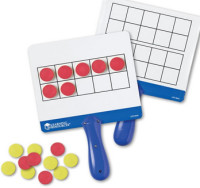
Reinforce counting, 1-to-1 correspondence, base 10, place value, number patterns, operations and more. The students are less frustrated as the counters don’t slide around. This product is not as heavy duty as I would like for a classroom but is wonderful for visualizing how many red and how many yellow equal 10. I would not put it out for everyday use.
7. Geoboards
Geoboards are used in the exploration and recognition of shapes, designs, spatial relationships, angles, fractions, area, perimeter, symmetry, and coordinates. I prefer using the larger geoboards. The knobbed pins hold the rubber bands in place. Be sure to buy plenty of extra geoboard elastic bands in various colors and sizes.
8. Large geometric solids
3D geometric solids come in sets that usually have a common 3″ dimension to illustrate relationships between area, volume, shape, form, and size.
Try and get a set that comes with a cone, a sphere, a hemisphere, a cube, a cylinder, a rectangular prism, a hexagonal prism, a triangular prism, a square pyramid and a triangular pyramid. Preschool and kindergarten children learn new vocabulary as they play with the blocks. They are also available in see through plastic.
9. One inch blocks/cubes
One-inch cubes are durable 1″ hardwood cubes that come in six colors and are perfect for beginning counting, patterning, color recognition, teaching basic geometric concepts and building. They are also great for beginning measurement activities such as – Show me how many one inch blocks are as long as the side of the book.
10. A pocket chart with number cards 0 – 100
I included a one hundred pocket chart in my list of ten best math manipulatives because kids love touching and moving the number cards, counting along or pointing to them with a long ruler.
They constantly ask questions or make observations such as, “Why do all the numbers in this row start with 6? All the numbers in this row end with a zero.”
As children play with the number cards they begin to see number patterns, learn about skip counting, become aware of odd and even numbers and increase their understanding of numbers.
Be sure to place it low enough so children can reach it easily.
 If your class has older buddies, they love to tidy up the one hundred pocket chart.
If your class has older buddies, they love to tidy up the one hundred pocket chart.
MORE!
I added a second page of terrific kindergarten and primary math manipulatives here…
Kindergarten-lessons.com is a participant in the Amazon Services LLC Associates Program, an affiliate advertising program designed to provide a means for sites to earn advertising fees by advertising and linking to Amazon.com. In other words, I do earn a bit of money if you buy from my links!


